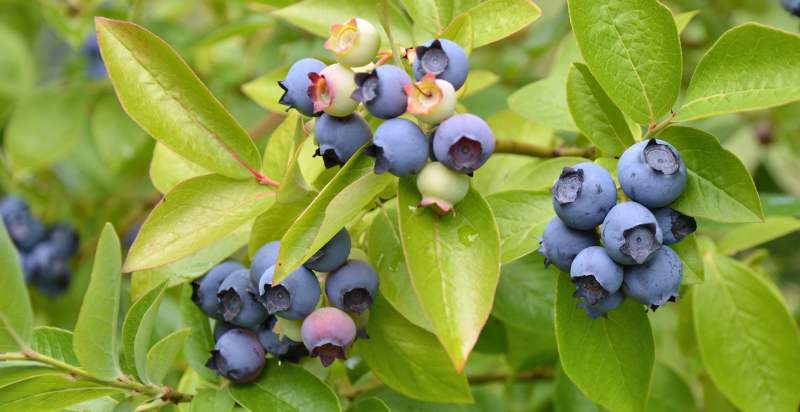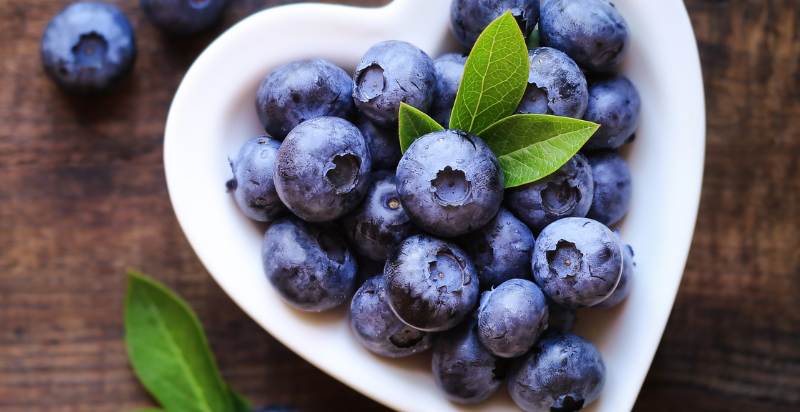Blueberries are a popular and healthy berry that is native to North America. Indigenous people and settlers alike have enjoyed them for centuries, but their popularity has only grown in recent years due to increased awareness of their health benefits. In this article, we’ll discuss the history of blueberries, how they’re harvested, their nutritional value, and other interesting facts about this delicious fruit.
What are Blueberries:
Blueberries are perennial flowering shrubs of the genus Vaccinium, including cranberries and bilberries. They have an oblong shape, blue-gray tinted skin, and small hairs on the surface. The inside is pale green or yellowish, juicy, and sweet with a hint of acidity. Blueberries are available fresh during the summer months when they’re in season, but frozen varieties can be found year-round.
History:
Members of the Wabanaki tribe first discovered the wild blueberry in Maine in the 1600s. It quickly became one of their main sources of food and medicine. Since then, it has spread across North America and become integral to many cultures’ diets. Blueberries are now grown commercially in the United States, Canada, and Mexico for global consumption.
Types of Blueberry:
There are many different types of blueberries. The most common type is the highbush blueberry, which grows in clusters and can reach up to 12 feet tall. Lowbush blueberries have shorter stems that grow close to the ground and are much smaller than their highbush counterparts. Most cultivated varieties are a hybrid between the two, resulting in a bushier plant with larger berries that can be harvested more easily.
Nutritional Value of Blueberries:
Blueberries are packed with vitamins, minerals, and antioxidants. They are a good source of vitamin C, dietary fiber, manganese, and other essential nutrients. They also contain polyphenols – powerful plant compounds that have anti-inflammatory and antioxidant properties. Blueberries are low in calories and fat but high in fiber, making them a great choice for those watching their weight. Their sweet flavor and small size also make them a popular snack food. Blueberries can be eaten fresh, frozen, dried, or cooked into pies and other dishes. They are also used to make jams, syrups, juices, smoothies, and ice cream.
The benefits of consuming blueberries are far-reaching. They may help reduce the risk of heart disease, cancer, and diabetes; help improve memory and brain function; boost immunity; protect against urinary tract infections; and even help with weight loss. Studies have shown that regular consumption of blueberries can also lower blood pressure, improve cholesterol levels, enhance vision health, reduce inflammation, and protect the skin from aging. All in all, blueberries are an extremely beneficial food in your diet. So go ahead – enjoy this delicious fruit!
Health Benefits of Blueberries:
Blueberries are a great source of antioxidants, which help protect our bodies from oxidative damage and can help reduce inflammation. They also contain several vitamins and minerals, including vitamins A, C, K1, manganese, copper, and dietary fiber. Research has shown that consuming blueberries may help improve heart health by reducing cholesterol levels, as well as reducing blood pressure and the risk of stroke.
Furthermore, blueberries have also been linked to improved brain health, with some studies suggesting they may help slow age-related cognitive decline. Lastly, blueberries may benefit weight loss due to their low-calorie and high-fiber content. So adding them to your diet can be a great way to get various health benefits.
How to Plant Blueberries?
Blueberries are one of the healthiest and most delicious fruits that nature has to offer. Planting blueberry bushes is a great way to have fresh blueberries during the summer months, but it takes some knowledge and skill to get them started. This guide will provide information on how to plant and care for your blueberry bushes so you can enjoy a bountiful harvest of fresh blueberries every year.
Soil Preparation:
Blueberries need soil rich in organic matter and well-draining, so preparing the area before planting your bushes is important. If the soil is too compacted, consider adding sand or compost to loosen it up. You should also test the pH of your soil with a testing kit, as blueberries need acidic soil to thrive. The ideal pH range is between 4.5 and 6.
Selecting Blueberry Varieties:
When selecting blueberry varieties, you’ll first want to consider the type of climate where you live. If you have cold winters and hot summers, look for low-chill tolerant varieties so they can withstand temperature changes. Also, note which types will produce the best flavor for your area; some are sweeter than others.
Planting Blueberry Bushes:
Once you’ve chosen your variety, it’s time to begin planting. First, dig a hole the size of the root ball and add some compost or other organic material to the soil before planting. Make sure that you plant your bushes at least four feet apart so that they have enough room for growth. Water thoroughly after planting and then mulch around each bush with straw, shredded leaves, or hay.

Caring For Your Blueberry Bushes:
Now that you’ve successfully planted your blueberry bushes, it’s important to care for them properly to keep them healthy and produce plenty of delicious fruit. Blueberry need acidic soil, so test regularly with a pH testing kit to ensure it stays within the ideal range of 4.5-6. In addition, make sure to water them regularly and fertilize them with a fertilizer specifically formulated for blueberries. You may also want to prune or thin out the branches to promote better airflow and fruit production.

Harvesting Blueberries:
When it’s time to harvest your blueberries, you’ll know as they will turn from green to blue/purple when ripe. Ensure not to overharvest, as this can reduce yields in future seasons. Gently twist off the berries from the bush and store them in an airtight container in the refrigerator until you are ready to enjoy them!
By following these steps, you can ensure that your blueberry bushes are healthy and produce plenty of delicious fruit each season. With patience and care, you can enjoy a bountiful harvest of fresh blueberries yearly.
Planting and caring for blueberry bushes is a rewarding experience that can provide you with years of delicious fruit. By following the steps outlined in this guide, you’ll be well on your way to enjoying a bountiful harvest every summer. So make sure to start preparing for next season now.
How to Care for and Grow Blueberries?
Once planted, blueberry bushes need regular care and maintenance to ensure they produce a bountiful harvest of delicious fruit. Here are a few tips on how to properly care for blueberry bushes:
- Water your plants regularly; blueberries need plenty of water to thrive. Ensure to provide them with at least 1 inch of water per week during the growing season.
- Fertilize your plants using an acid-based fertilizer specifically formulated for blueberries. This will help keep the soil pH balanced and encourage healthy growth.
- Prune your bushes as needed; this helps promote better air circulation and allows more light into the bush, which can result in larger berries.
- Mulch your plants with hay, straw, or shredded leaves to help keep the soil moist and discourage weeds.
- Test your soil regularly to ensure it has an acidic pH between 4.5 – 6; blueberries need acidity to thrive.
By following these steps, you can ensure that your blueberry bushes are healthy and produce plenty of delicious fruit each season. You can enjoy a bountiful harvest of fresh blueberries with patience and care every year.
Preventions From Pests and Diseases:
Blueberry bushes are prone to various pests and diseases that can threaten the health and productivity of your plants. Here are some ways to protect them from common issues:
- Plant your blueberry bushes in an area with plenty of sunlight to help prevent fungal diseases.
- Encourage beneficial insects like ladybugs, lacewings, and bees; they will feed on aphids and other pests that can damage your plants.
- Avoid overcrowding by planting at least four feet apart and regularly pruning so that air can circulate freely around your bushes.
- Inspect your plants regularly for signs of disease or insect damage, such as discolored leaves or holes in the fruit, and take steps to treat the affected area.
By taking preventive measures, you can ensure that your blueberry bushes stay healthy and productive for years to come. With careful attention and proper care, you can enjoy a bountiful harvest of fresh blueberries every year.
With these tips in mind, growing and caring for blueberry bushes is an easy and rewarding experience that can provide you with years of delicious fruit. So don’t wait any longer – start preparing for the next season now.

How to Harvest a Blueberry?
When it’s time to harvest, blueberries will be ripe and ready for picking when they are dark blue. To pick them, use your hands or scissors to twist off the bush’s berries gently. Avoid tugging on them, as this can cause damage to the plant. It would help if you also avoided harvesting unripe berries that are still green or white; these won’t ripen once picked and won’t taste as good as the berry that has been left to .
Once your berries have been harvested, store them in an airtight container in the refrigerator until you are ready to enjoy them! With proper care and maintenance, you can look forward to enjoying a bountiful harvest of delicious blueberries every summer.
How to Store Blueberries?
Once harvested, blueberries can be kept in the refrigerator for up to two weeks. To store them properly, place the berries in an airtight container and lay a paper towel on top before closing to absorb any moisture. This will help keep them fresher for longer.
You can also freeze blueberries for extended storage; spread them out on a baking sheet and place them in the freezer for several hours until they are completely frozen, then transfer them to an airtight container or zipper-lock bag and store them in the freezer for up to 6 months. Frozen blueberries retain their flavor and are perfect for adding to smoothies, muffins, pancakes, or other recipes that call for fresh fruit.
Following these simple tips, you can easily store your blueberries and enjoy them for months. With a little bit of preparation, you can look forward to enjoying the sweet taste of freshly picked blueberries all year round!

How to Use Blueberries?
Blueberries are incredibly versatile and can be enjoyed in many ways. Here are some ideas for how to incorporate them into your diet:
- Add blueberries to oatmeal, yogurt, or cereal for a nutritious breakfast.
- Use them as a topping on pancakes or waffles.
- Puree blueberries and add them to smoothies for a delicious and nutritious drink.
- Toss blueberries with your favorite salad greens for a sweet and savory flavor combination.
- Make an easy dessert by baking blueberries in puff pastry or topping ice cream.
- Create a healthy snack by combining blueberries, nuts, and dark chocolate chips.
- Make your homemade blueberry jam or jelly.
- Add fresh blueberries to trail mix for a sweet and crunchy treat.
- Use them as a garnish on cakes and pies.
- Mix frozen blueberries into pancake batter for extra flavor and nutrition.
- Enjoy them straight from the carton as a delicious and nutrient-packed snack.

Potential Risks from Blueberries:
While blueberries are a nutritious and delicious snack, they do come with risks. Unripe or moldy berries can cause stomach upset, so ensure only to eat fully ripened blueberries. Additionally, blueberry plants can contain harmful bacteria that can lead to food poisoning if consumed. It is important to wash all berries thoroughly before eating them. Finally, always choose organically-grown berries when possible to avoid exposure to pesticides and other contaminants.
Blueberries are a great source of many vitamins and minerals and offer many health benefits. With proper care and handling, you can enjoy these tasty fruits for many years!
We hope these tips have helped you understand how to select, store, and use blueberries. Enjoy the sweet taste of summer all year long.
Conclusion:
Blueberries are a nutritious and tasty fruit that can be enjoyed fresh or frozen. With proper selection, storage, and use, you can enjoy the sweet taste of blueberries all year long! Just remember to eat fully ripened berries and wash them thoroughly before eating. Choosing organically-grown ones when possible is important to avoid pesticide exposure.
By following these tips, you’ll be sure to get the most out of your blueberry harvest each summer season! So go ahead and pick those juicy berries – you won’t regret it! Good luck and happy harvesting!
- Everything You Wanted to Know About Red Tamarillos - June 2, 2025
- A Guide to Tulips: Everything You Need to Know & More… - June 2, 2025
- Guanabana: Description, Flavor, Benefits, And Uses - May 27, 2025

13 thoughts on “What are Blueberries? How to Plant, Grow, and Harvest Blueberries”
Comments are closed.